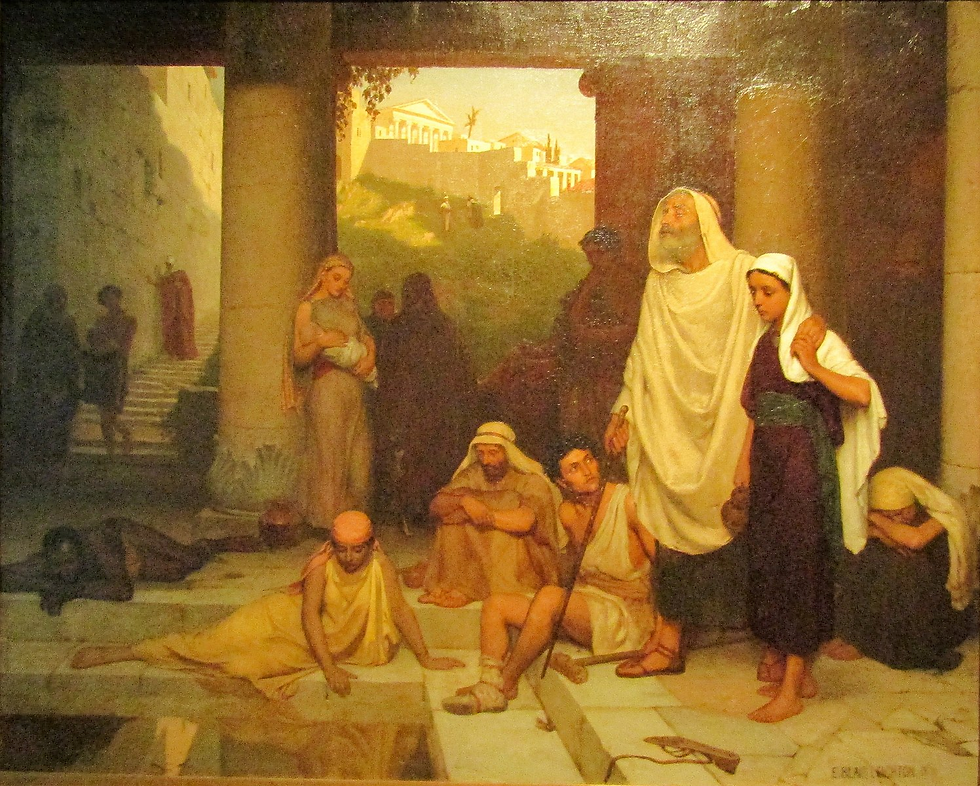WAS IT HARSH AND UNFAIR?
- John Moore

- Jul 10
- 4 min read
By John W. Moore
Imagine the ridicule and the stares! The man from Nazareth, Jesus, the curious teacher from the temple, had just mixed his saliva with dirt from the ground and wiped it on a poor blind man’s eyes!

Then, on top of that, he told the blind man to walk from where they stood near the temple down the crowded, precipitous street to the Pool of Siloam to wash his eyes. How would he find his way without sight? Why would Jesus want him to do such a thing?
Reaching the pool isn’t easy and the path is steep. From the temple mount in Jerusalem to the pool, there is an elevation drop of 345 feet. It would certainly have been daunting for a blind man to navigate the numerous steps of varying widths in the midst of a crowded street (see the illustration above).
I’ve walked this path on several occasions, and also a few times underground along portions of the actual first century street. Even going downhill is challenging.
At the southern extreme of the ancient city of David, the recently discovered Pool of Siloam (pictured above) was a popular place for ritual cleansing and public gatherings. The pool aided in the supply of water for the residents of Jerusalem. Its water came from the Gihon Spring and was "sent" through Hezekiah's tunnel down to a large reservoir in the central valley. According to John's gospel, the word Siloam means “sent” (John 9:7), and it was to this pool that Jesus, the one "sent" by God, "sent" a blind man to wash and be healed.

When you compare the task required of the blind man to the manner in which the man at the pool of Bethesda was healed—being told to get up and walk (John 5:8)—it might seem a bit unfair and harsh. The blind man’s path to recovery was painstaking and slow, but the healing of the lame man was instantaneous and immediate.
But who are we to question the method and means by which the Lord chooses to grant a blessing? He always loves, and he always sympathizes, no matter the affliction we may have to bear. He is always touched by the feeling of our infirmities (Hebrews. 4:14-16).
In John 9, with the case of the man who was born blind, his struggle with blindness had occurred over the course of his entire life. Now, he was being asked to struggle just a little while longer as he made that arduous trek down to the pool of Siloam. But why?
Why did his healing require so much more? Did he need to prove himself? Did his faith need to be refined (James 1:2-4). Did his faith need to be revealed (James 2:14-26). Perhaps; but maybe there is something more to the story.

Could it be that his struggle and journey toward healing was meant to glorify God and bring others to faith? After all, it wasn’t every day that a blind man with mud on his eyes walked down a long, steep path in Jerusalem.
The drama of the entire scene would have captured a lot of attention—attention that would ultimately point to Jesus. A lot of talk would have followed, and questions were sure to arise about why a blind man, at the command of an itinerant preacher, would walk so far under such harsh circumstances.
In the end, maybe the blind man’s journey wasn’t so much about him. Maybe it was for others. Maybe it was for you and me. Not only did his healing prove that Jesus was the Messiah so that we can believe today, but it also reveals to us the very nature of faith.
The blind man’s difficult walk is evidence of the confidence and trust that others have in Jesus. He obeyed the Lord’s command even when it was hard and probably didn’t make sense to him.
As a result, his journey brought attention to Jesus and caused others to follow him. Even today, you and I believe on the Lord, in part, because of what John tells us about the blind man.
So, let us remember that as we face our own struggles and end up having to endure our own personal pain, it is how we respond to the struggle and pain that can impact the faith of others.
While our struggle for healing may look different from others, and might even be more difficult, it could—in the long run—serve as a greater testament of faith. It may end up bringing greater attention to the power of Jesus and the work of the Messiah, especially in those times when we are NOT healed in the way we desire.
Whatever happens in our own personal journey for healing, rest assured that if we trust in Jesus, there will always be a healing. It may or may not be physical, but there will be a healing.
In the case of the apostle Paul, his thorn in the flesh was never removed, but his faith was perfected because of the struggle (2 Corinthians 12:7-10), and all of us today are encouraged by what he endured and the testimony he bore.
It may not always seem fair, and we may not understand, but regardless of our circumstances, let us walk in faith and use our story to the glory of God.
By JWM



Comments